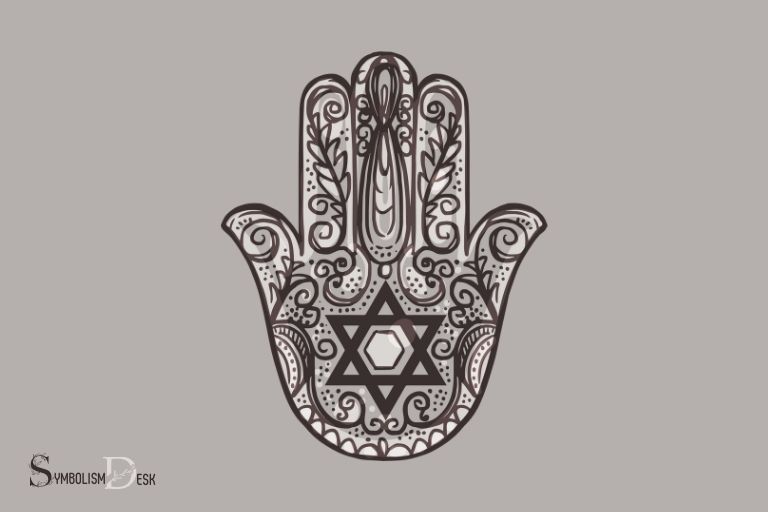What Does the Hand Symbol Mean in Judaism? Protection!
The hand symbol in Judaism is known as the Hamsa, which represents protection, blessings, and good fortune.
The Hamsa, also called the Hand of Miriam, is a popular symbol in Jewish tradition, originating from the Middle East. It is believed to have protective properties, warding off negative energies and the evil eye.
The symbol carries spiritual significance and is often used as an amulet or talisman.
The Hamsa’s popularity transcends religious and cultural barriers, making it a symbol of peace, tolerance, and unity. It serves as a reminder to rely on faith, hope, and spirituality during challenging times.
By embracing the Hamsa, individuals can harness its protective qualities and invite blessings and good fortune into their lives.
8 Symbolisms: Meanings of the Hand Symbol in Judaism
| Meaning/Symbolism | Description |
|---|---|
| Protection | The Hamsa is often worn as a protective amulet against negative energies and the “evil eye.” It’s believed to ward off harm and bring blessings. |
| Divine Blessings | Symbolizes divine protection, blessings, and guidance from a higher power, particularly in times of adversity. |
| Universal Symbol | Represents a shared symbol in various cultures, including Judaism and Islam, uniting people across different faiths in the pursuit of positive energies and protection. |
| Hand of Miriam | In Jewish tradition, the Hamsa can be referred to as the “Hand of Miriam,” representing Miriam, the sister of Moses and Aaron, and her attributes of compassion and protection. |
| Five Fingers | The five fingers of the Hamsa often symbolize the five books of the Torah in Judaism, emphasizing the importance of divine teachings and guidance. |
| Balance | The Hamsa’s symmetry and equilibrium symbolize balance and harmony, representing the interconnectedness of various elements in life. |
| Faith and Spirituality | Reflects a person’s faith in a higher power and their spiritual beliefs, fostering a sense of connection to the divine. |
| Cultural Identity | Serves as a cultural and religious symbol within Judaism, reminding individuals of their heritage and identity. |
Key Takeaway

Five Facts About: The Hand Symbol Mean in Judaism
Origin And History Of The Hand Symbol In Judaism
The hand symbol is one of the most recognizable religious symbols in judaism. It is believed to have originated centuries ago and has been incorporated into jewish art and culture in various ways.
We will explore the origin and history of the hand symbol in judaism, specifically delving into the hand of miriam and the hand of fatima.
The Hand Of Miriam And The Hand Of Fatima
The hand of miriam, also known as hamsa, is a popular symbol in judaism and is believed to bring good luck and ward off evil.
The hand of miriam is shaped like a hand with five fingers, with a design that includes an eye or a star of david in the palm.
It is often worn as a necklace or a bracelet and is a common decoration in jewish homes.
On the other hand, the hand of fatima, or khamsa, is the islamic version of the hamsa and is widely popular in the middle east and north africa. It is often used as an amulet to protect against the evil eye.
The symbols’ similarities include the five fingers and the eye or star of david in the center.
Why The Hand Symbol Is Popular In Judaism
The hand symbol is popular in judaism because it represents the hand of god or the hand of aaron, the brother of moses who was the first high priest.
It is also believed to symbolize the hebrew letter shin, which has three prongs and represents one of god’s many names.
The hand symbol is considered a powerful talisman that can protect and bring good luck to those who display it.
The Origins Of The Hand Symbol In Ancient Judaism
The origin of the hand symbol in ancient judaism is not entirely clear. Some believe that it symbolizes the hand of god reaching down from heaven to touch the earth, while others believe that it represents the outstretched hand of aaron, known as the “hand of blessing. ”
The hand symbol also appears in ancient jewish tombstones and synagogues, suggesting its significance in early jewish communities.
How The Hand Symbol Was Incorporated In Jewish Art
The hand symbol has been incorporated into jewish art in various ways.
In addition to jewelry and amulets, the symbol can be seen in illustrations of biblical texts, ketubahs (jewish marriage certificates), and mezuzahs (small boxes containing sacred texts that are attached to doorposts).
The symbol is often intricately designed with colorful patterns and embellishments, making it a beautiful and meaningful addition to jewish art.
The hand symbol is a significant and deeply symbolic symbol in judaism, dating back centuries. Its popularity has grown worldwide, with its incorporation into art, jewelry, and everyday use. The hand symbol, often referred to as the Hamsa or Hand of God, is believed to provide protection, peace, and blessings to those who embrace it. Its universal appeal has inspired various interpretations, with some connecting it to spiritual resilience and strength. In modern contexts, the phrase “diamond hand symbol meaning” has even surfaced, symbolizing unwavering commitment and persistence, blending ancient tradition with contemporary ideals.
Whether worn as an amulet or displayed in a home, the hand symbol remains a powerful representation of divine protection and a testament to the rich history of jewish culture and traditions.
Symbolic Meanings Of The Hand Symbol In Judaism
The hand symbol is one of the most widely recognized symbols in judaism. It has been used to convey various meanings throughout history.
Some religious scholars believe that it is one of the oldest symbols in judaism. It is often used to represent several different concepts such as god’s protection or a symbol of creation.
The Hand Symbol: A Sign Of Protection
The hand symbol is often used as a sign of protection in judaism. It is believed to ward off evil spirits and protect against the evil eye.
The concept of the hand of god, which is the idea that god has a guiding hand in the world, is deeply ingrained in jewish theology.
As a result, the hand symbol is often used as a representation of this idea of divine protection.
- The hand symbol is commonly used as an amulet or charm to ward off evil spirits.
- The hand symbol is often seen in jewish artwork, particularly in the form of hamsas.
- Many jews believe that having a hand symbol or hamsa in their home can provide spiritual protection.
The Hand Symbol: The Hand Of God
In judaism, the hand of god is a concept that refers to the idea that god is actively involved in the world. The hand symbol is often used to represent this concept.
- The hand symbol is frequently used to represent god’s presence in the world.
- In jewish artwork, the hand symbol is often depicted holding or supporting the world.
- The concept of the hand of god is closely related to the idea of divine providence, which suggests that god is guiding the world towards a particular goal.
The Hand Symbol: A Symbol Of Creation
The hand symbol is also used as a symbol of creation in judaism. It is believed that god created the world using his hands.
- The hand symbol is often used to represent the act of creation in jewish artwork.
- The hand symbol is frequently seen in depictions of the creation of adam in jewish artwork.
- The idea of god using his hands to create the world is deeply ingrained in jewish theology and is often referenced in jewish prayer.
The Hand Symbol: A Symbol Of Unity And Peace
In addition to protection, divine presence, and creation, the hand symbol is also used as a symbol of unity and peace in judaism.
- The hand symbol is often seen in depictions of the menorah, which is a symbol of unity in judaism.
- The idea of god’s hand bringing peace is often referenced in jewish prayer.
- The hand symbol is frequently used in jewish wedding ceremonies as a representation of the unity between the bride and groom.
The Hand Symbol: Meaning In Kabbalah
In kabbalah, the mystical interpretation of judaism, the hand symbol has various symbolic meanings.
- The hand symbol is believed to represent the 10 sefirot, which are the ten attributes of god.
- The hand symbol is often seen as a representation of divine providence and guidance.
- The idea of the hand of god is central to kabbalah, and the hand symbol is often used in kabbalistic amulets and charms.
The hand symbol is a deeply significant symbol in judaism, with a variety of symbolic meanings. It is often used to represent god’s protection, divine presence, creation, unity, and peace.
Its significance is not limited to judaism alone, and the hand symbol has become a popular symbol of spirituality and protection in many cultures around the world.
Different Interpretations Of The Hand Symbol In Judaism
The Hand Symbol: A Cultural And Traditional Icon
The hand symbol, or hamsa, is a significant symbol in judaism and has been used for centuries.
It is a cultural and traditional icon that is believed to protect people from harm and bring good fortune. The hand symbol is also commonly referred to as the hand of god, hand of miriam or hand of fatima.
Variations In Interpretation Of The Hand Symbol Across Jewish Communities
The hand symbol is interpreted differently across different jewish communities. Some consider it a symbol of protection, while others view it as a representation of the five books of the torah.
Here are some variations in interpretation of the hand symbol:
- In some jewish communities, the middle finger is longer than the others, representing the hebrew letter “shin,” which stands for one of god’s many sacred names.
- The hand symbol is often used as a blessing and prayer before or after meals.
- In sephardic jewish culture, the hamsa is frequently decorated with fish or an eye, which are both symbols of protection against the evil eye.
- The hand symbol is also a popular symbol in jewish art, jewelry, amulets, and home decor.
The Hand Symbol In Jewish Folklore And Legends
The hand symbol holds a significant place in jewish folklore and legends.
Some of the popular beliefs and legends are:
- The hand symbol was a gift given to sarah, abraham’s wife, by king solomon to protect her from the evil eye.
- The hand symbol was used by the biblical prophet elisha to bring a dead boy back to life.
- According to jewish tradition, the hand symbol was used by queen esther to protect the jewish people from an evil decree issued by the persian king.
The hand symbol is an important part of jewish culture and tradition that holds different interpretations across jewish communities.
It is a symbol of protection and good fortune that has been used for generations to ward off evil and bring blessings.
Ritualistic Use Of The Hand Symbol In Judaism
The Hand Symbol: Ritualistic Use In Judaism
Judaism is a religion that values symbolism, and the hand symbol is one of the most recognizable symbols in this faith.
The hand symbol, also known as the hamsa or the hand of miriam, has been a part of jewish culture and religion for centuries.
This symbol represents protection, strength, and blessings. In this section, we will discuss the ritualistic use of the hand symbol in judaism, including prayer, life cycle rituals, and protection rituals.
The Hand Symbol: Use In Jewish Prayer
Jewish prayer is an integral part of daily life for many jews around the world. The hand symbol is often used during prayer to provide a sense of protection and blessings.
Some specific ways the hand symbol is used in jewish prayer are:
- Holding the hand symbol during prayer to help focus and connect with spirituality.
- Placing the hand symbol near the prayer book or on the wall as a way to remind oneself to pray.
- Wearing jewelry with the hand symbol during prayer, such as necklaces, bracelets, or rings.
The Hand Symbol: Use In Jewish Life Cycle Rituals And Celebrations
Judaism is a religion that places a great deal of importance on tradition and rituals. The hand symbol is often used in life cycle rituals and celebrations to provide protection and blessings for the person being celebrated.
Here are some ways the hand symbol is used in these rituals:
- In the brit milah, or circumcision ceremony, a piece of jewelry with the hand symbol may be given to the baby as a symbol of protection and good luck.
- During a bar or bat mitzvah ceremony, the hand symbol may be used as a decorative element on invitations, centerpieces, and other items.
- The hand symbol may be incorporated into wedding ceremonies, either as jewelry worn by the bride or groom, or as a part of the ceremony itself, such as a chuppah adorned with hand symbols.
The Hand Symbol: Use In Protection Rituals
The hand symbol is also used in protection rituals to ward off evil spirits and provide blessings.
Here are some specific protection rituals where the hand symbol is used:
- Preparing for shabbat by washing hands and saying the blessing over a hand symbol candlestick.
- Placing the hand symbol on the doorpost of a home as a way to protect the inhabitants from harm or negativity.
- Wearing jewelry with the hand symbol to provide a sense of protection and good luck.
The hand symbol is an essential part of jewish culture and religion, serving as a symbol of protection, strength, and blessings. This symbol is used in a variety of contexts in judaism, including prayer, life cycle rituals, and protection rituals.
By using the hand symbol, jewish individuals aim to connect with their spirituality and receive blessings from a higher power.
The Modern-Day Relevance Of The Hand Symbol In Judaism
The Hand Symbol: Popular Use Today
The hand symbol used in judaism, also known as the hamsa or the hand of fatima, has become increasingly popular worldwide. It is used as a decorative symbol in jewelry, apparel, and home decor.
Some key points to consider are:
- The symbol is interpreted as a protective talisman.
- It gained increased popularity in recent years, particularly across social media platforms.
- It is not solely limited to the jewish faith. It is also used in muslim communities, and its popularity has transcended geographical and religious boundaries.
The Hand Symbol: Use In Jewish And Non-Jewish Art
The hamsa has been prominently used in jewish and non-jewish art for centuries. From ancient times to modern-day, artists have incorporated this symbol in their work.
- In jewish art, the hamsa is often depicted with hebrew letters and phrases.
- It is used in tapestries, paintings, and sculptures.
- In non-jewish art, it has been incorporated in various forms such as fashion accessories, wall hangings, and tattoos.
The Hand Symbol: Adoption By Other Religions And Faith Traditions
The hamsa or hand symbol is no longer exclusive to judaism or islam. It has been adopted by other faiths around the world
- In christianity, the hand symbol is seen as a representation of the hand of god or the holy spirit.
- In hinduism, it is known as the hasta mudra and is believed to have healing powers.
- The buddhist community uses the hamsa or the hand symbol in their meditation practices.
The Hand Symbol: Use In The National Flag Of Israel
The hamsa is an important part of the national identity of israel and is featured in its flag.
- The blue and white flag of israel features the star of david and a hamsa.
- It is a symbol of the country’s heritage and inextricable jewish identity.
- The hamsa on the israeli flag is in its traditional form with an eye in the centre, which is believed to ward off evil.
The Hand Symbol: Significance In Today’S Political Climate
In today’s highly polarized political climate, the hamsa or hand symbol has become a potent symbol of hope and unity.
- It is seen as a symbol of resistance against racism, nationalism, and discrimination.
- It is used in protests and rallies worldwide to advocate for unity and peace.
- It serves as a reminder of our shared humanity and the importance of respect and empathy towards one another.
Is the Hand Symbol in Candy Crush Inspired by the Hand Symbol in Judaism?
The hand symbol meaning candy crush boost does bear a resemblance to the hand symbol in Judaism. However, it is crucial to note that the origin and purpose of these symbols differ greatly. The hand symbol in Candy Crush represents a helpful boost to progress in the game, while the hand symbol in Judaism holds religious and cultural significance, symbolizing divine protection and blessings.
FAQ About on What Does The Hand Symbol Mean In Judaism
What Is The Hand Symbol In Judaism?
Jews use the hand symbol, hamsa, to ward off evil and bring good luck.
Where Did The Hand Symbol Originate From?
Hamsa represents the hand of god in judaism, and it was first used in ancient mesopotamia.
What Does The Hand Symbol Mean In Islam?
In islam, the hand symbol is called khamsa, and it symbolizes the five pillars of islam.
What Are The Different Names For The Hand Symbol?
The hand symbol is called hamsa in judaism, khamsa in islam, and hand of fatima in other cultures.
How Is The Hand Symbol Used Today?
The hand symbol is used as a charm or amulet to bring good luck, protect against evil, and promote blessings.
Conclusion
The hand symbol is a significant icon in judaism that represents a variety of meanings. It has a rich history in jewish beliefs and traditions, and continues to hold a special place in the hearts of people till today.
The hand symbol can often be seen in jewish art, jewelry, and even in the way jewish people greet one another.
It signifies protection, blessing, unity, and peace, among other things. Whether it is the hand of god or the hand of miriam being referenced, the hand symbol is a powerful way to connect with the divine.
Overall, the hand symbol is a beautiful representation of the jewish faith and all that it stands for.
Its prominence in the religion is a reminder of the importance of tradition, community, and spiritual connection. May the hand symbol continue to be a source of strength and inspiration to jewish individuals all around the world.






